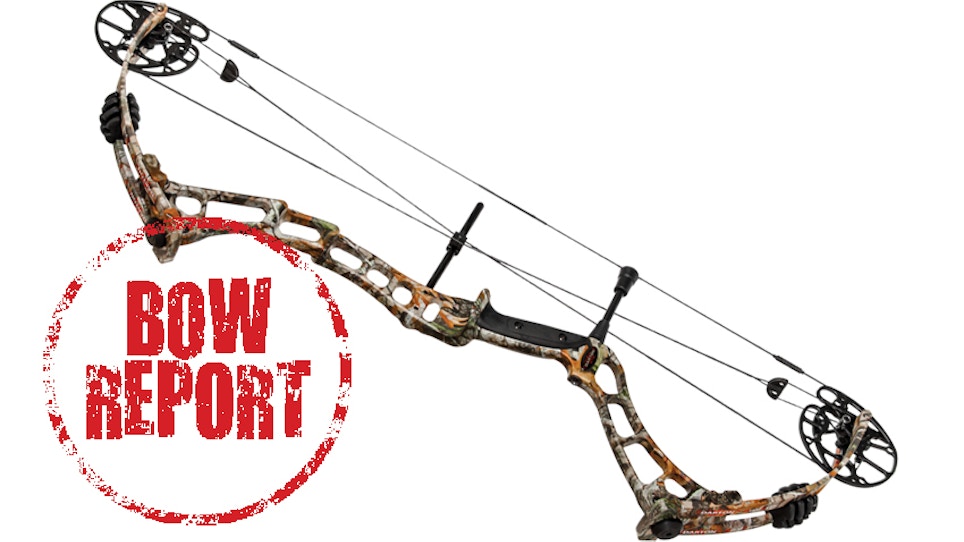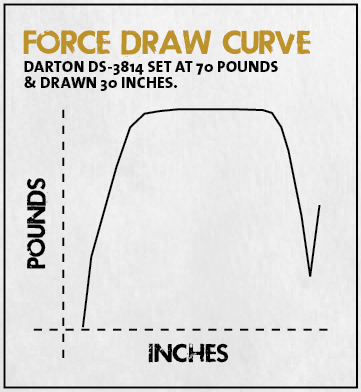Darton’s original Pro-3800, introduced in 2010, was a bow ahead of its time. It achieved speeds approaching 350 fps IBO without sacrificing shootability, and it spawned a long line of spin-offs including one of Darton’s latest, the DS-3814. Happily, in this model, Rex Darlington and his team have not changed the basic qualities that made the Pro-3800 bow so successful. However, this bow line has evolved with a minor tweak or two each year.
 In this evolution have been slight modifications to the DualSynch cams with deeper tracks. The cable guard reduces torque. A cosmetic Soft Touch Finish makes for a less metallic look and feel, and available camo patterns have changed. The riser, limbs, and limb pockets changed little, though the geometry of the cutouts on the riser are slightly different now than on the original, and the machining has been modified to give a smoother, less angular appearance. The string stop has been improved to provide additional dampening; the original came with two stops, the current version has only one, though purchasing a second stop to mount closer to the cable guard is an option. Darton has always been very particular about its strings and now uses America’s Best Strings. The grip has been improved as well to be more comfortable and to promote greater consistency shot-to-shot. One thing about the grip that has not changed is the option of removing the standard rubber grip and replacing it with a slicker, skinnier grip (supplied) for those who prefer that style grip.
In this evolution have been slight modifications to the DualSynch cams with deeper tracks. The cable guard reduces torque. A cosmetic Soft Touch Finish makes for a less metallic look and feel, and available camo patterns have changed. The riser, limbs, and limb pockets changed little, though the geometry of the cutouts on the riser are slightly different now than on the original, and the machining has been modified to give a smoother, less angular appearance. The string stop has been improved to provide additional dampening; the original came with two stops, the current version has only one, though purchasing a second stop to mount closer to the cable guard is an option. Darton has always been very particular about its strings and now uses America’s Best Strings. The grip has been improved as well to be more comfortable and to promote greater consistency shot-to-shot. One thing about the grip that has not changed is the option of removing the standard rubber grip and replacing it with a slicker, skinnier grip (supplied) for those who prefer that style grip.
Last year Darton introduced 3 Axis Center Pull Technology, a design in which the arrow is centered on all three axes relative to the riser, string, and cams. This is not common; in most bow designs the grip is at or closer to the vertical center of the bow with the arrow resting above it, and in many designs the arrow is offset from the horizontal center of the riser as well. In theory, three-axis centering should contribute to less torque, better nock travel, and a generally more easily tuned bow.
The DualSynch Cam that is still at the heart of the bow is module-specific. Draw length is adjustable without a press, but modules must be swapped out to effect the change. Modules are available in half-inch increments from 25 to 31 inches. In addition, letoff is adjustable from 80 percent down to 65 percent by simply screwing any of three draw stop module sets to the cams. Doing so naturally changes draw length slightly. Draw weights cover the standard maximum weights of 50, 60, and 70 pounds, each adjustable downward approximately 10 pounds. Set screws must be loosened, then retightened after turning the limb bolt.
Between the 3 Axis Center Pull Technology, the DualSync Cams, the torque-reducing cable rod, the ergonomic grip, the new string suppression system, and a few other features such as the way the cables are yoked to improve limb stability, the DS-3814 boasts state-of-the-art technology.
Fit and finish has long been excellent on Darton bows, but the newer Soft Touch finish, in addition to the less angular machining, does enhance the DS-3814’s appearance.
Shooting The Bow
The shelf/riser would appear to accommodate any rest, including those with set screws. An orientation line on the shelf aids in finding center shot; tuning and sighting in the model tested proceeded quickly and smoothly. The grip, as billed, is very comfortable and I believe it does promote shot-to-shot consistency. I generally prefer a skinnier grip and made the switch with the sideplates included in the package. I also prefer 80 percent letoff, but did test the optional draw stop modules included, which are simple to install and work as advertised for those who prefer less letoff.
Darton recommends that the string stop be adjusted to just touch the string at rest. On the model tested there was a tiny gap, so I made the simple adjustment before testing the bow.
A pair of hash marks on each cam makes it easy to confirm that the cams are properly oriented and draw lengths unchanged at a glance. Seen from the side, each cable should be between the hash marks. This inspires confidence when changing modules or letoff, or when tweaking draw length, or when the passage of time or use of the bow in extreme conditions gives rise to concern about string creep. Bringing the cam orientation back to spec is simply a matter of pressing the bow and twisting or untwisting the cables a few turns.
A mass weight of 4.1 pounds puts the DS-3814 in the middle of the pack, neither on the light side nor inordinately heavy. The axle-to-axle length of 33-13/16 inches has not changed since the original Pro-3800 and is slightly longer than most bows currently on the market.
The draw force curve on the DS-3814 is remarkable and confirms the smoothness of the DualSync Cams. In fairness, a draw force curve may indicate humps, bumps, or sharp drop-offs that are hardly (or even not at all) perceived by the shooter. The opposite cannot be said, though; a draw force curve that suggests a smooth draw cycle is always going to be perceived that way unless the shooter is over-bowed.
This bow’s cutting-edge technology has been described above. The extent to which the three-axis centering, yoked cables, torque-reducing cable guard, ergonomic grip, and other features contribute to the bow’s shootability in terms of steadiness at full draw, perceived forgiveness, ease of tuning, and the lack of recoil or vibration is difficult to say. Arguably there is a synergistic effect created by the combination of all those features. In any case, this is a bow that achieves very high speeds without sacrificing shootability.
A very prominent bowhunter and CEO from another bow manufacturer once remarked (complained?) to me that no one ever asks him what is tried and true; people only want to know what is new. After nearly five years since the introduction of the original 3800, the designers at Darton have managed to develop a bow that is both tried and true and cutting-edge new.
Darton DS-3814 Specs
Letoff: 80%, adjustable down to 65%
Brace Height: 6 inches
Weight: 4.1 pounds
Axle-To-Axle Length: 33.8 inches
Speed: 345 to 350 fps IBO/ATA
Draw Lengths: 25 to 31 inches, adjustable with modules
Draw Weights: 50, 60 and 70 pounds peak, adjustable down 10 pounds from peak
Options: Upper bowstring noise suppression system available. Next Vista, Shadow Black, Limited Edition, Muddy Girl, and Target Red finishes. Alternate grip (provided).
Suggested Retail: $948
Objective Tests (30 Inches Draw)
Peak Hold*: 70 pounds
Weight, Full Draw*: 17.2 pounds
*Rounded to nearest half-pound
At 70-Pound Draw Weight
| Arrow Weight | Speed @ Launch | Speed @ 20 Yards | K.E. @ Launch | K.E. @ 20 Yards |
| 385 grains | 316 fps | 306 fps | 85.5 ft. lbs. |
80.0 ft. lbs. |
| 500 grains | 279 fps | 270 fps | 86.5 ft. lbs. | 81.0 ft. lbs. |
At 60-Pound Draw Weight
| Arrow Weight | Speed @ Launch | Speed @ 20 Yards | K.E. @ Launch | K.E. @ 20 Yards | Sound Level |
| 385 grains | 285 fps | 274 fps | 69.5 ft. lbs. | 64.0 ft. lbs. |
59.4 dBA |
| 500 grains | 254 fps | 246 fps | 71.0 ft. lbs. | 67.0 ft. lbs. | 57.7 dBA |







